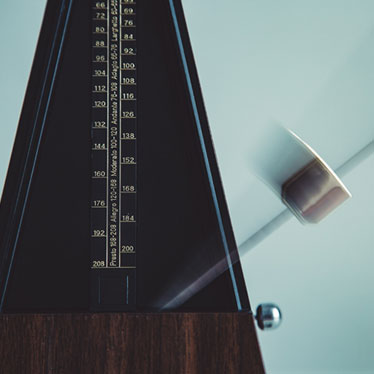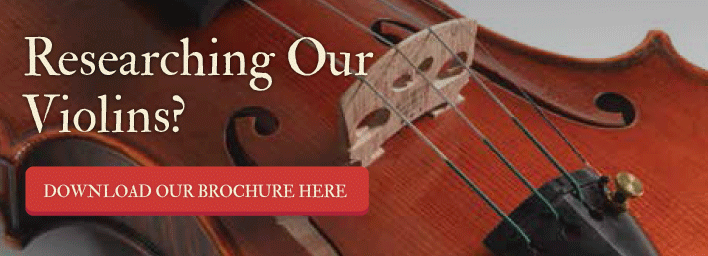Metronomes: Why You Need One And Where To Get Them

Learning the notes on the staff, and correlating finger positions on your string instrument are Part 1 of musicianship. Understanding time signatures, rhythm and tempo are an equally important Part 2.
While some students have a more innate rhythmic sense, all beginning and intermediate students benefit from the use of a metronome, a musical tool that marks the tempo by "sounding" a consistent beat.
7 Benefits of Using a Metronome
Metronomes come in all different styles and sizes (more on that below) but all have the same, utilitarian purpose; they create some type of sound - typically a click or a tick, but there are also voice options available. The sound repeats at a preset, steady tempo - indicated by BPMs (beats per minute).
Tempo is important for several reasons:
1. Students develop "tempo sense."
The steady beat provided by the tempo becomes ingrained in the brain and body over time, developing an inner-sense of tempo. Eventually, you'll only need the metronome to check BPM on a particular piece or to help you with phrasing particularly difficult rhythmic patterns (or when you use it in music lessons with your own students someday...)
2. Subdivide the beat.
Your metronome may allow you to subdivide the beat - which means it will click the main beat as well as the 16th-note beats, for example, going one step further in ensuring you play the rhythm accurately.
3. Learn more unique beats.
Many of the digital metronomes out there will help you learn unique beats - such as a bossa nova or other rhythmic patterns common to different cultures. This is especially helpful for bass players or string players interested in playing outside the classical music genre.
4. The composer cares.
The BPMs are often indicated at the top of the sheet music by the composer, so playing a piece at the written tempo is just as important as playing the correct notes and rhythms. Over time, students develop an intuitive awareness of what the BPMs will feel like, but it takes time and practice to develop that level of muscle memory.
5. Develop greater musical awareness.
Sometimes, we become so focused in our brains and bodies – and a particular musical section or phrase in front of us – we lose sight of the piece as a whole. Using a metronome forces you to listen to something else and this actually brings a greater awareness to the piece in its entirety – particularly when you're playing with others.
6. To hone practice techniques.
There are different ways to incorporate metronomes into practice to hone your technique. For example, beginning students are encouraged to set the metronome at a slower tempo (like beginning at 84 BPM for a piece marked 112 BPM - and slowly increasing the tempo as they improve). Intermediate students need to be careful, however, to not reach a "speed wall." If you want to use a metronome for a particular difficult passage, it's better to determine your fingering plan ahead of time, mark it on the music, and then use the metronome to keep a consistent tempo.
7. Keep your peripheral vision alive.
Musicians always need to have their peripheral vision "on" to follow the conductor's movements and/or the lead of the accompanying musicians around them. Practicing with a metronome that has a visual accompaniment with the sound, can help you become a better peripheral "watcher" of the space around you while playing.
Recommended Metronomes for String Players
Here are some highly-rated metronome options for string players. When possible, support a local music store. If not, there are plenty of online sources - like Amazon - to choose from.
Online apps are free and easy
There are many online music apps for strings players, many of which are free (or very low-cost) and almost all of which include metronome options of some sort.
The Cherub WSM 330 is simple and reliable
This metronome is basic, but has everything you need – including the swinging pendulum referenced above. The Cherub WSM 330 ranges from $20 to $50, depending on where you purchase it. It does not need any batteries, carries from 40 to 208 BPM and boasts high-grade mechanics.
Keep accurate time with a Seiko SQ50-V Quartz Metronome
The Seiko brand has long been known for producing high-quality, lasting time pieces. Those same mechanics result in the accuracy and reliability of their Seiko SQ50-V Quartz model. At a very affordable $25 and a compact, durable, and portable design, it's a popular model among string musicians.
The Boss DB-90 metronome is "the boss"
It's $150 price tag makes the Boss DB-90 Metronome an intermediate/advanced players-only accessory. However, once you've established you're sticking with your instrument, it's a worthy metronome to invest in as it has 50 different memory options, and intuitive programming abilities. It also offers a human voice count option, which is less distracting for some musicians.
Metronomes are an effective teaching/learning tool for musicians of all ability levels. Start practicing with one and you'll notice the difference in your ability to better read - and feel - tempo and rhythm.


